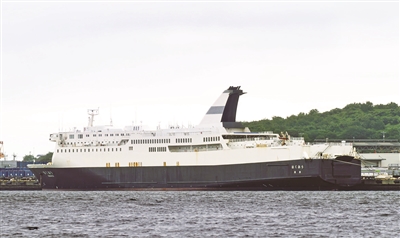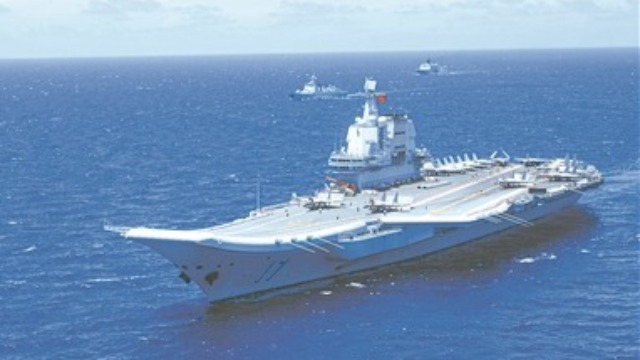By Liu Cheng
刘澄

Shin Nihonkai Ferry's HAKUOU passenger ship
新日本海轮渡公司的“白鸥”号渡轮。The Japanese Defense Ministry is in talks with several commercial ferry companies about using civil transport capacities to undertake military tasks, Japanese media reported. The move is to cover up Japan's strengthened war preparedness with a "civil" cloak and to establish an amphibious transport and logistics supply model similar to that of the US, which will facilitate their defense cooperation.
据日本媒体报道,日本防卫省正与多家商业轮渡公司谈判,推动民用运力担负军事运输任务。此举意在“以民掩军”加强战备,同时建立类似美军的两栖运输和后勤补给模式,与美军在防务领域加强合作。
It is reported that the Japanese Defense Ministry already signed contracts in August this year to continue leasing Shin Nihonkai Ferry's HAKUOU passenger ship and Tsugaru Kaikyo Ferry's Natchan World passenger ship to transport JSDF's tanks and other armored vehicles. The two ships currently leased are as capable as military transport ships and able to transport two combat reconnaissance battalions or 60 armored vehicles. Besides, commercial ships performing military tasks are difficult to detect and can select the optimal route with military support.
报道称,今年8月,防卫省已签订合同,继续租用新日本海轮渡公司的“白鸥”号和津轻海峡轮渡公司的“世界”号两艘大型渡轮,来运送日本自卫队的坦克等装甲车辆。从运输效果来看,目前租用的两艘渡轮运送能力可比肩军事运输舰,能够运送2支满建制的战斗侦察营或60辆坦克等装甲车辆。而且,商用渡轮隐蔽性较强,在军方支持下可优先选择最佳航行路线。
According to analysts, there are two reasons why the JSDF, is increasing the use of commercial resources for military purposes,10 years after it introduced civil transport capacities. For one thing, its previous exercises and training have verified the effectiveness of commercial ships. For instance, during the massive joint military exercise "Keen Sword 23", HAKUOU and Natchan World delivered more than 700 JSDF members and 230 tanks and other armored vehicles from Kagoshima and Hokkaido to Kyushu and the southwestern islands of Japan.
分析人士指出,日本自卫队在引入民用运力10年后,进一步加大商业资源的军事使用,一方面是在此前的演习和训练中验证了商业渡轮的使用效果。比如,在“利剑23”大规模联合军事演习期间,“白鸥”号和“世界”号渡轮承担从鹿儿岛和北海道向九州及日本西南诸岛投送兵力的任务,共运送700余名自卫队员和230辆坦克等装甲车辆。
For another, the JMSDF, with only three large amphibious transport ships, complains about its small capacities. Although the Japanese Defense Ministry has announced a plan to form a maritime transport fleet, the R&D of new ships will take a long time and cost a great deal of money, not to mention the shortage of sailors needed on amphibious transport ships. Therefore, it hopes to lease more commercial ships to make up for its inadequate transport capacity.
另一方面,日本海上自卫队自称运输能力薄弱,仅列装3艘大型两栖运输舰。虽然防卫省宣布要组建海上运输群,但新舰研发建造周期长、费用高,且两栖运输舰配套舰员数量紧张,因此希望通过加大租用商业资源来弥补运力缺陷。
In addition to leasing civil ships, the Japanese Defense Ministry also plans to grant commercial sailors as "JSDF reserves" and incorporate them in the "reserve maritime transport fleet". According to the contract with relevant ferry companies, about 21 sailors will be recruited per ship, which will help reserve maritime transport personnel who can quickly switch into military roles in wartime, and also save expenses as these people are mainly paid by commercial companies. On another note, according to the Japanese Defense Ministry's two-year defense budget, at least 19 civil docks will be transformed into dual-purpose ports in the future.
除“收编”民用船舶外,防卫省还要赋予商业公司船员“预备自卫队员”身份,将其纳入“海上运输预备队”。目前,与相关公司的合作预计将按照每船21人的编制进行录用。日本政府既可借此储备军事海运人员,确保他们在战时快速转换身份,又可节省经费开支,因为这部分人员的薪资主要由商业公司承担。另据防卫省连续2年的防务预算安排,未来将有至少19个民用码头被改建成军民通用港口。
Analysts said the enhanced employment of civil transport capacities for military purposes is another means of Japan's disguised military buildup, something it has been doing with greater intensity over recent years. Private Japanese companies are playing an important role in the military industry, and Japan has invested nearly 100 billion Yen this year to enhance the resilience of the supply chain of military-industrial products. Recently, it has also intensified interactions and collaboration with countries such as the UK, Germany, France and Australia in military bases and logistics supply.
分析人士指出,日本扩大民用运力军事化使用,是其以民掩军、变相扩军的又一手段。近年来,日本逐渐加大“藏军于民”力度。在军工领域,日本民营企业发挥着重要作用;今年内,日本投入近千亿日元用于“军工产品供应链韧性”建设。近期,日本还加强与英国、德国、法国、澳大利亚等国在军事基地和后勤补给领域的互动和协作。
As America's loyal follower in the Indo-Pacific region and beyond, Japan often imitates America's military moves. The US Navy and Army consistently lease a large number of commercial ro-ro ships – the largest one exceeding 55,000 tons – to transport troops worldwide, and they have formed preset fleets out of these leased ships and deployed them in various mission sea areas. Inspired by this, JMSDF also plans to organize its leased ships into a "reserve fleet" and distribute them to JMSDF's multiple bases.
作为美国在印太地区乃至全球的“跟班”,日本经常效仿美军开展军事动作。美国海军和陆军长期租用大量商用滚装船来执行全球兵力调遣任务,其中最大的超过5.5万吨,并基于这些船舶建立海上预置舰队,常态化部署于多个任务海区。受此影响,日本海上自卫队也要将租赁的商用运输船组建为“商船预备队”,并分配给海上自卫队的多个基地使用。
It's worth noting that according to the logistics cooperation agreement between the US and Japan, several Japanese military-industrial enterprises will build ship and plane repair and maintenance centers for the US military in the Indo-Pacific. This means Japan's civil transport capacities and other potential war resources may be turned into quasi-military forces that can be used to interfere in regional affairs under the framework of US-Japan defense integration. Once the US and its allies and partners obtain the right to use such civil resources either temporarily or for a long time, they will be able to expand the coverage of their military pivots in the Asia Pacific and make their military operations in the region more efficient.
值得注意的是,根据美日达成的后勤合作协议,日本多家军工企业将建设美军在印太地区的船舶和飞机维修保养中心。这意味着日本的民用运力等战争潜力资源,可能在美日防务一体化战略框架下,变成干涉地区事务的准军事力量。一旦美国及其盟友获得相关民间资源的长期或临时使用权,将扩大在亚太地区的军事支点覆盖范围,提升在该地区开展军事行动的效率。




















